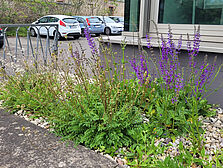Indigenous, indigenous to the area, what exactly does that mean?
The use of indigenous plants and even plants that are indigenous to the area is becoming an increasingly important topic. But what does it mean? So are all other plants the “bad guys”?
This bed was created in spring 2022 by the Professorship of Plant Design in collaboration with the park maintenance team. A year earlier, local seeds were purchased and grown in the greenhouses of the Geisenheim University. For various reasons, not every seed germinated reliably, so as planting got closer, we looked for a nursery that offered local planting material to supplement some species
We were advised by the local Professorship for Biodiversity and Ecosystem Functions, which deals with the effects of global change on species and habitats, the protection, restoration and sustainable use of biodiversity and the importance of biodiversity for ecosystem services.
Across the EU, living creatures are divided into two categories: indigenous and alien species. Indigenous species occur naturally in a region (e.g. Germany) or have migrated independently, without human intervention, and have established themselves there. Alien species have been introduced intentionally or accidentally by humans. These are of course useful and ornamental plants that were and are specifically imported. But there are also “stowaways” who travel with goods or seeds, for example. For foreign plant species, it depends heavily on the time at which they were introduced. If species were introduced before or in 1492, i.e. the rediscovery of America, they are called "archaeophytes"; these are largely established in our ecosystems. After 1492 they were called "neophytes", and here too there were some established species but also many unstable ones. It becomes dangerous with neophytes that spread in our natural areas and thus attack the local ecosystems. When this happens it is called "invasive".
These classifications are intended to help protect biodiversity, especially genetic diversity - an important goal.
Further information
BfN about alien and invasive species (german)When it comes to plants, the phrase “indigenous in a specific area” refers to indigenous species that have been occurring naturally in a specific natural area for a long time. Most plants are found in many places in Germany. However, due to the different site conditions (soil, water balance) that prevail there, the species can differ genetically. This creates a large intraspecific diversity that is in a balance of adaptation and deviation.
It is therefore particularly important that only species that have their genetic origin in this specific region are introduced into the wild; this is even anchored in some laws such as the Federal Nature Conservation Act or the Forest Propagation Act (corresponding to §40 paragraph 4 and § 7 Paragraph 2 No. 8 BNatSchG). This aspect is an important factor to consider in plantings that are intended to contain indigenous species.
The few indigenous species that can be found in modern plant design are often already selected for attractive characteristics. Genetically diverse wild species are unpredictable and adaptable, making it difficult to plan. Of course, it is desirable that the flower is particularly large or the appearance is reliable. But this selection can severely deplete a plant's gene pool. There is a risk that this depleted gene pool will cross into local wild species populations and cause damage there. Similar problems can arise if the plants are not originally native to the area in which they are planted. Therefore, there are now certified seeds for near-natural plantings and plantings in the open landscape. Certified planting material is already available in the area of woody plants, but unfortunately there are still few nurseries that specialize in native perennials, grasses, ferns and onion plants.
There are some tools to support planning with native plants, such as the BfN's Floraweb website or atlases with distribution maps. Seed and planting material dealers have different categories with areas of origin that can be selected according to your own region. In this way, local ecosystems can be protected.
Indigenous plants, especially if they are indigenous to a particular area, know the local microclimate and, when used in the same region, can have an advantage. Of course, this only applies if they are used appropriately for the location. If a plant comes from the Rhine floodplains, it will not grow well in the dry, hot greenery surrounding the road - indigenous or not. Provided they are not overly selected, indigenous wild species can also score points for their adaptability and flexibility. This works well when the overall appearance and plant location are not so important, but the planting appearance can have a natural "disorder".
But it cannot be said across the board that these species are “better”. They are part of our regional flora and can be used to form a genetic and ecological stepping stone in urban areas in times of declining biodiversity and natural habitats.
This planting consists of plant species that are indigenous to a specific area and that are allowed to express their full intraspecific diversity. What is observed is whether the possible variations in the appearance or the way these plants grow can create an orderly and attractive plant bed. For example, you can also observe a more intense reaction of the plants to weather fluctuations. They don't behave in a predictable way, but rather in a way that allows them to survive well in this location. A not so attractive but pragmatic survival strategy. Such behavior is less common in heavily modified breeds.
In general, the question arises as to whether somewhat wilder, indigenous species or even protected species can be integrated into suitable plantings in order to preserve and develop populations.
back to Campus South
back to Parks & Open Spaces












